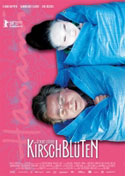

Opening 6 Mar 2008
Directed by:
Doris Dörrie
Writing credits:
Doris Dörrie
Principal actors:
Elmar Wepper, Hannelore Elsner, Nadja Uhl, Maximilian Brückner, Aya Irizuki
Living a quiet life in Munich, Trudi (Hannelore Elsner) is confronted with the fact that her husband Rudi (Elmar Wepper) has not much time left. She has been the solid ground for her husband, who needs to live life as a constant routine that never weavers. With the revelation that death is about to knock at the door, she decides that they need to visit their children and convinces her husband to do so without telling him the reason why. During their visiting of two of her children in Berlin, it is clear that the children and grandchildren dont have time for them. Trudi does get the opportunity to go to a Butoh dance with her younger daughters girlfriend. This moment reawakens her old dreams that she had left behind but never forgotten. From a book it is revealed that she was a Butoh dancer and wanted the opportunity to go to Japan and dance before Mount Fuji.
What is Butoh dancing? The creator of Butoh dance was Tatsuma Hijikata who developed it in the 1950s. He said Dance can be defined as a dead body standing with his life at a risk. The dancers wear a death mask and move like shadows. At the press conference director Dorris Dörrie explained that recently there had been a documentary on television on this subject, and she and Wepper had seen it and in that instant realized that a movie needed to be made from this idea which is implicated in this dance. Trudi dies before telling Rudi that he is terminally ill, but he sets off to fulfill her unfilled dream of going to Japan and seeing their oldest son. Dörrie uses the impermanence of the cherry blossoms, a homeless girl who is a Butoh dance in the park, and Mt Fuji to alter Rudi just enough that he accomplishes his final goal. The movie is filled with obvious cliches but done with a quick wit which leaves you laughing and sad at the same time. (Shelly Schoeneshoefer)